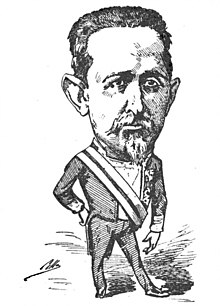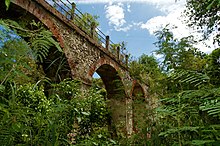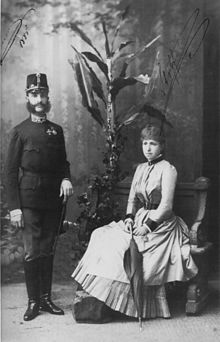Alfonso XII of Spain
Alfonso XII of Spain, nicknamed "the Pacifier" (Madrid, November 28, 1857-El Pardo, November 25, 1885), was king of Spain between 1874 and 1885. Officially the son of Queen Isabel II and King Consort Francisco de Asís de Borbón, with the beginning of his reign the First Republic ended and the period known as the Restoration began. After his premature death at twenty-seven, a victim of tuberculosis, he was succeeded to the throne by his posthumous son, Alfonso XIII, whose minority was headed by the regency of his mother, the widowed queen Maria Cristina.
Biography
Early Years
She was born in the Royal Palace of Madrid on November 28, 1857. A rumor circulated in Madrid and at court, also during her pregnancy, that her real father was not the king consort, Francisco de Asís de Borbón, but the then lover of the queen, the engineer captain Enrique Puigmoltó y Mayans, 3rd Count of Torrefiel and 1st Viscount of Miranda, which is why in some popular media the newborn was called the Puigmoltejo.
Alfonso, who received the title of Prince of Asturias after his birth, had four sisters: Infanta Isabel, Countess of Girgenti (1851-1931), Infanta María del Pilar (1861-1879), Infanta María de la Paz, Princess of Bavaria (1862-1946) and Infanta María Eulalia, Duchess of Galliera (1864-1958). He was baptized on December 7, 1857 in the chapel of the Royal Palace of Madrid by the Patriarch of the Indies, his godfather being Pope Pius IX represented by the nuncio, Lorenzo Barili.
Among the tutors of the young Prince Alfonso were the Duke of Sesto and the Archbishop of Burgos, the latter chosen by Queen Isabella herself after consulting with Pius IX.
Overthrow of the Elizabethan monarchy and education
In 1868, while he was still a child, his mother Elizabeth II was dethroned by the Revolution of 1868 (known as La Gloriosa), forcing the royal family to go into exile. Isabel and Francisco de Asís settled separately in Paris. The young Alfonso's departure to Europe was an invaluable experience, as he thus encountered other political systems such as the French, the Austro-Hungarian or the British. In fact, he was the first prince of Asturias to be trained in foreign educational and military centers.
The first of these was the Stanislas College in Paris. The Franco-Prussian War caused the family to move temporarily to Geneva, where in addition to receiving private classes, Alfonso attended the Public Academy of the cantonal city. As a continuation of his education, the Royal and Imperial Teresian Academy of Vienna (Collegium Theresianum) was chosen, where, after the Franco-Prussian War, Prince Alfonso was accompanied by William Morphy, Count of Morphy (1836-1899), a trusted man of Queen Elizabeth II, who chooses him as tutor. Previously, the Count of Morphy had already been designated a gentleman of entry, on the occasion of the prince's sixth birthday, accompanying him during his exile in Paris, and contributing to his training, with private lessons.
During his stay at the Teresian College in Vienna, from February 1872 until the end of his studies in June 1874, Morphy played a crucial role in shaping Prince Alfonso's character and intelligence. He devised a teaching program in which he would attend to the integral formation of Prince Alfonso, giving attention to his humanistic training, physical exercises and visits to museums, factories and other establishments and places of interest, in addition to instructing him in constitutional law. Finally, Prince Alfonso attended the Sandhurst Military Academy in England. In this country he learned first-hand of English constitutionalism. From Alfonso's correspondence with his mother during all his stays in the different schools and academies, the relative economic straits in which the royal family lived in those years are revealed. On June 25, 1870, her mother, Isabel II, abdicated her dynastic rights, in a document signed in Paris, in favor of her son Alfonso, who thus came to be considered by the monarchists as the legitimate King of Spain.
Meanwhile, different forms of government followed one another in Spain: the Provisional Government (1868-1871), the democratic monarchy of Amadeo I (1871-1873) and the First Republic (1873-1874). This was liquidated in the month of January by the coup d'état of General Pavía, and a second period of provisional governments began. During this historical period (the Democratic Six-year period), the Alfonsine cause was represented in Parliament by Antonio Cánovas del Castillo.
Cánovas de Castillo was very attentive to the prince's education, supervised by a supporter of his, the Duke of Sesto. According to Ramón Villares, thanks to the tour he took through various foreign schools in Paris, Geneva and Vienna to end up at the English military academy at Sandhurst, Prince Alfonso "acquired command of languages and a regular knowledge of European history, as well as some one of the most appreciated political theorists of the time (Bejamin Constant, Walter Bagehot). His intellectual curiosity did not reach the levels of some contemporary monarchs, such as the young Don Pedro V of Portugal, but judging by the impression he made on the foreign observers and because of the books that he had bought as soon as he arrived at the Palacio de Oriente, his training made him more like a liberal European monarch than his immediate Spanish ancestors, as traditional as they were little cultivated. After all, the most novel thing was precisely his condition of having been the first monarch of modern Spain who had been educated almost entirely in exile, without pomp or etiquette ».
Access to the Crown and reign
On December 1, 1874, Alfonso made public the Sandhurst Manifesto, presenting himself to the Spanish as a Catholic prince, Spanish, constitutionalist, liberal, and desirous of serving the nation.
On December 29, 1874, the monarchy was restored when General Arsenio Martínez-Campos Antón pronounced himself in the Valencian town of Sagunto in favor of Prince Alfonso's accession to the throne. At that time, the head of state was General Serrano and the head of government was Sagasta. In January 1875 he arrived in Spain and was proclaimed king before the Spanish Cortes. Alfonso XII appointed the Count of Morphy his private secretary. From this position, he became a great protector of the artists of his time, interceding in the granting of pensions by the Royal House and had a strong presence in the cultural institutions of Restoration Madrid.
At the head of the monarchy comes a young monarch in contact with modern Europe, willing to combine all efforts for the modernization of Spain. Alfonso XII's regenerative purposes were explained by Morphy himself to Julio Nombela in a "long and substantial conference”, shortly before Sagunto's pronouncement:
"... the main purpose of the young monarch was to completely and radically change the spirit of the country. It would go little by little, depriving importance of what had until then been called politics, giving them to the education and instruction of all social classes, to culture, to industry, to trade, to sciences, letters and the arts. The beautiful ideal of the monarch was to transform Spain, to make it enter into the European concert more like Carlos III than the other kings of the dynasty he represented, and to achieve in this way that intellectual and moral progress replaced the political and financial intrigues, the civil discords; in a word, the unfortunate delay in which after the glorious war of Independence had lived Spain."
His reign consisted mainly of consolidating the monarchy and institutional stability, repairing the damage that the internal struggles of the years of the so-called Revolutionary Sexennium had left behind, earning him the nickname "the Pacifier". The new Constitution of 1876 was approved and during that same year the Carlist war ended, led by the pretender Carlos VII (the monarch himself made an appearance and went to the battlefield to witness its end). The Basque and Navarrese privileges were reduced and hostilities in Cuba were temporarily stopped with the signing of the Peace of Zanjón. In 1878 and 1879 he was the victim of two attacks perpetrated by anarchists from which he emerged unscathed.
Alfonso XII made an official visit to Belgium, Austria, Germany and France in 1883. In Germany he accepted the appointment as honorary colonel of a regiment of the garrison of Alsace, a territory conquered by the Germans and whose sovereignty France claimed. This fact gave rise to a hostile reception of the Spanish monarch by the people of Paris during his official visit to that country. Germany tried to occupy the Caroline Islands, at that time under Spanish rule, causing an incident between the two countries that ended in favor of Spain with the signing of a Spanish-German agreement in 1885, although it implied the loss of the Marshall Islands in favor of Spain. the Germans, as well as the right to establish a naval base in the Carolinas.
According to Ramón Villares, «he was a popular monarch, thanks to his brief marriage with his cousin María de las Mercedes and gestures such as his early visit to the Northern army, or his presence, not always approved by the government, in dejected places due to some tragedy (floods, cholera epidemics…). Popularity that, in a more programmed way, he wanted to achieve by making trips to different parts of the kingdom. It was a complementary way of legitimizing the monarchy. (...) "The king is loved more when he is seen more than being one", Durán y Bas warned Cánovas in 1877, requesting a royal visit to the Catalan provinces that was not from & #34;step"... The calendar of the king's internal travels was, despite his poor health, very intense. In fact, he ended up personally visiting a large part of the Spanish regions, as well as its main institutions ».
Death
In 1885, a cholera epidemic broke out that spread to the interior of the country. When the disease reached Aranjuez, the monarch expressed his desire to visit those affected, to which the Government of Cánovas del Castillo refused due to the danger that this entailed. The king then left without warning for the city and ordered that the Royal Palace of Aranjuez be opened to house the troops of the garrison. Once there, he comforted the sick and distributed aid to them. When the Government learned of the sovereign's trip, he sent the Minister of Grace and Justice, the Captain General, and the Civil Governor to take him back to Madrid. When he arrived, the people, aware of the king's gesture, greeted him with cheers and, withdrawing the horses, led the carriage to the Royal Palace of Madrid.
A short time later, on November 25, Alfonso XII died of tuberculosis in the Royal Palace of El Pardo. He has dedicated a monument in the Retiro Park in Madrid, next to the large pond.
Arriving on the throne at such a young age, Afonso had not taken any apprenticeship in statecraft. With a benevolent and understanding character, he won the affection of his people by fearlessly visiting neighborhoods devastated by cholera or devastated by the Andalusian earthquake of 1884. His ability to deal with men was considerable, and he never allowed himself to become an instrument of no particular party. During his brief reign, peace was established both at home and abroad, finances were well regulated, and the various administrative services were placed on a footing that later enabled Spain to get through the disastrous war against the United States of 1898 without the threat of a revolution. The death of the king meant the beginning of the political pact between Cánovas and Sagasta, the so-called "pact policy" or "policy of the turn", in addition to other pacts, such as the military and the religious.
Family
Marriages and offspring
Alfonso XII married twice; with his cousin María de las Mercedes de Orleans, daughter of the Dukes of Montpensier, he married on January 23, 1878; However, the queen died of typhus or tuberculosis five months later, and in a second marriage the king married Maria Cristina de Habsburgo-Lorraine (November 29, 1879), a second cousin of Emperor Franz Joseph I of Austria. He had three children from his second marriage:
- María de las Mercedes (1880-1904), Infanta de España y Princesa de Asturias. Consorte to Carlos de Borbón-Dos Sicilias (1870-1949).
- María Teresa (1882-1912), Infanta de España. Consorte devoted Fernando de Baviera.
- Alfonso XIII (1886-1941), king of Spain since his birth, for this came after the death of his father. Consorte Victoria Eugenia de Battenberg.
In addition to his legitimate children, Alfonso XII left at least two illegitimate children with the contralto Elena Sanz:
- Alfonso (1879-1970).
- Fernando (1881 -1922).
Alfonso XII's widow, María Cristina, was regent of Spain until her son Alfonso XIII came of age, in 1902.
Family tree
| 16. Carlos III de España | ||||||||||||||||
| 8. Carlos IV de España | ||||||||||||||||
| 17. Maria Amalia de Saxony | ||||||||||||||||
| 4. Francisco de Paula de Borbón | ||||||||||||||||
| 18. Felipe I de Parma | ||||||||||||||||
| 9. María Luisa de Parma | ||||||||||||||||
| 19. Luisa Isabel de France | ||||||||||||||||
| 2. Francisco de Assisis de Borbón | ||||||||||||||||
| 20. Fernando I de las Dos Sicilias | ||||||||||||||||
| 10. Francisco I de las Dos Sicilias | ||||||||||||||||
| 21. Maria Carolina of Austria | ||||||||||||||||
| 5. Luisa Carlota de Borbón-Dos Sicilias | ||||||||||||||||
| 22. Carlos IV de España | ||||||||||||||||
| 11. María Isabel de España | ||||||||||||||||
| 23. María Luisa de Parma | ||||||||||||||||
| 1. Alfonso XII de España | ||||||||||||||||
| 24. Carlos III de España | ||||||||||||||||
| 12. Carlos IV de España | ||||||||||||||||
| 25. Maria Amalia de Saxony | ||||||||||||||||
| 6. Fernando VII de España | ||||||||||||||||
| 26. Felipe I de Parma | ||||||||||||||||
| 13. María Luisa de Parma | ||||||||||||||||
| 27. Luisa Isabel de France | ||||||||||||||||
| 3. Isabel II of Spain | ||||||||||||||||
| 28. Fernando I de las Dos Sicilias | ||||||||||||||||
| 14. Francisco I de las Dos Sicilias | ||||||||||||||||
| 29. Maria Carolina of Austria | ||||||||||||||||
| 7. María Cristina de Borbón-Dos Sicilias | ||||||||||||||||
| 30. Carlos IV de España | ||||||||||||||||
| 15. María Isabel de España | ||||||||||||||||
| 31. María Luisa de Parma | ||||||||||||||||
Tribute names
Ships
- Alfonso XII (1891)
Places and institutions
- Spain:
- Madrid:
- Calle de Alfonso XII
- Monument to Alfonso XII
- Navarre: Fort of Alfonso XII
- Santa Cruz de Tenerife: Plaza del Príncipe
- Seville: Puente Alfonso XII
- Malaga: Plaza and garden of Alfonso XII
- Madrid:
- Philippines:
- Manila: Theatre of Prince Alfonso XII
- Puerto Rico:
- Ponce: Aqueducto Alfonso XII
- San Germán: Calle Alfonso XII
Civil Orders
- Order of Alfonso XII
Alfonso XII in fiction
Literature
Alfonso XII and the cursed crown (Altera, 2018) by Nieves Michavila, V Hispania Historical Novel Award.
Television
- The Ministry of Time (2017).
Theater
Juan Ignacio Luca de Tena premiered the play Where are you going, Alfonso XII? in 1957, which recreates the years of courtship and marriage between the king and María de las Mercedes de Orleans, as well as the death this. The actors who played the royal couple at the premiere were Jorge Vico and Luchy Soto. It was enormously successful and was adapted to the cinema by Luis César Amadori.
Novel
G (Planeta, 2015) by Daniel Sánchez Pardo recreates the arrival of Prince Alfonso in Spain in 1874 to be crowned king.
Cinema
- Where are you going, Alfonso XII? (Luis César Amadori, 1958). The actor Vicente Parra interprets the character of the king.
- Where are you going, sad of you? (Alfonso Balcázar, 1960). Sequel to the former in which Vicente Parra also interprets the role of the king.
Contenido relacionado
Priestly tradition
Sputnik 1
Heinrich Schliemann









